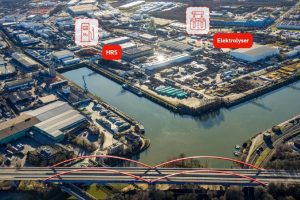For over 20 years, the research institute has conducted extensive research and development in Solid Oxide Electrolyzer Cell (SOEC) technology, laying the groundwork for its industrialization. Together, thyssenkrupp nucera and Fraunhofer IKTS aim to advance high-temperature electrolysis (SOEC) towards industrial manufacturing and application.
By the first quarter of 2025, a pilot plant designed and constructed by Fraunhofer IKTS is scheduled to commence operations. This facility will manufacture high-temperature electrolysis stacks with SOE cells – the core components of SOEC stacks, initially in limited quantities. The strategic partnership also grants thyssenkrupp nucera a license to produce and use CFY stacks, leveraging Fraunhofer IKTS’s SOEC technology.
SOEC stack technology is based on a gas-tight, oxygen-ion-conducting ceramic electrolyte with screen-printed electrodes and pressed interconnectors made from a chromium-based alloy (CFY). The electrolyte-supported cells, the choice of materials and the design ensure high efficiency, durability, robustness, and the potential for cost-effective mass production. The future industrialization of SOEC technology will build upon the results of ongoing research and development efforts.
“With SOEC system solutions, we are consistently implementing our company’s growth strategy. With high-temperature electrolysis, we will offer our customers an extremely powerful technology that will be another strong pillar of the new, CO₂-free and therefore climate-friendly energy mix of the future without fossil fuels,” said Dr. Werner Ponikwar, CEO of thyssenkrupp nucera. “Through the strategic partnership with Fraunhofer IKTS, we are strengthening our hydrogen product portfolio with a second high-performance technology for industrial scale in addition to AWE technology.”
Professor Dr. Alexander Michaelis, Director of Fraunhofer IKTS, added: “We are very pleased to contribute our world-leading research and development expertise in SOEC technology to the partnership with thyssenkrupp nucera. In addition to the higher efficiency in electricity-to-hydrogen conversion, high-temperature electrolysis also offers the great advantage that CO₂ can be actively extracted from the environment and converted together with green hydrogen into green synthesis gas and downstream products such as e-fuels. This is a key success factor for the energy transition. By upscaling CFY stack production, we are giving our system partners commercial access to this core component.”
The high energy efficiency of SOEC technology will primarily benefit industries in which industrial waste heat is generated during production, as its use significantly reduces electricity consumption. Waste heat is generated in the production of green steel, ammonia, methanol, fertilizers and energy storage, among other things. Moreover, the adoption of high-temperature electrolysis technology eliminates the dependence on rare precious metals.






